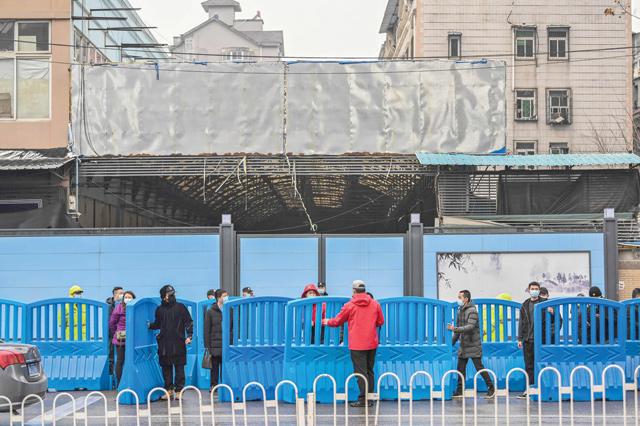- International News
- Mon-2021-02-01 | 04:26 pm

A team of World Health Organisation (WHO) experts investigating the origins of COVID-19 on Sunday went to a market in Wuhan where one of the first reported clusters of infections emerged over a year ago, with one member tweeting the visit was "critical" to understanding the virus.
Members of the group arrived at Huanan seafood market — which has been sealed since January last year — driving into its barricaded premises as guards quickly blocked others from entering, according to AFP journalists at the scene.
The mission has a remit to explore how the virus jumped from animal to human.
But with the fieldwork element of the trip in its early stages, WHO officials have already played down expectations of finding the source of a virus which has killed over two million people and devastated the global economy.
On Sunday, the WHO team visited Huanan market and another wholesale one, as part of a long-planned trip closely monitored by the Chinese authorities.
Team member Peter Daszak described the tours on Twitter as "very important site visits”, adding that the team had "met with key staff at both markets and asked questions to help better understand the factors involved in the emergence of COVID”.
Despite the fact that over a year has elapsed since the outbreak there, Daszak said speaking to staff and seeing the layout of the Huanan market was "very informative”.
The visits were "critical for our joint teams to understand the epidemiology of COVID as it started to spread at the end of 2019”, he said in another tweet.
The experts did not take questions, and a member of the team shrugged and rolled up the car window when asked about his expectations for the visit.
Security staff told reporters outside to leave and shook a tall ladder on which a photographer was sitting for a better view.
Later, in response to a shouted question on whether the experts were satisfied with access, a member of the mission gave a thumbs-up.
Blame game
Earlier this week, state media outlet Global Times published a report downplaying the importance of Huanan as an early epicentre of the virus, claiming "subsequent investigations” have suggested the market was not the source of the outbreak.
On Sunday, the tabloid argued that "the possibility that the coronavirus was passed on from cold-chain products into Wuhan, or more specifically, to the Huanan wet market... cannot be ruled out”.
Chinese officials identified wild animals sold in the market as a likely source of the outbreak in initial stages of the pandemic, clamping down on the exotic animal trade in response.
A price list issued by a merchant at the emporium, which circulated online, showed an array of exotic wildlife available including civets, snakes and even live wolf pups.
But, more recently, state media have thrown support behind suggestions that the virus may have originated elsewhere, with a resurgence of local infections blamed instead on imports.
Chinese authorities have relentlessly pushed a positive narrative of heroism and decisive action in their fight against the coronavirus that has spurred an economic recovery and kept deaths down to 4,636.
On Saturday, the WHO experts’ itinerary included an exhibition in Wuhan lauding the emergency response of the city’s health authorities.













